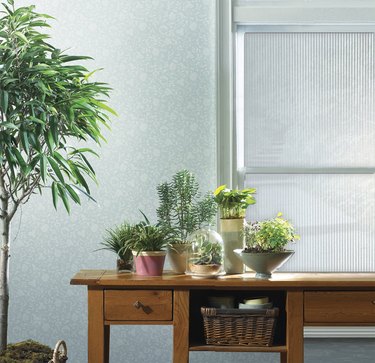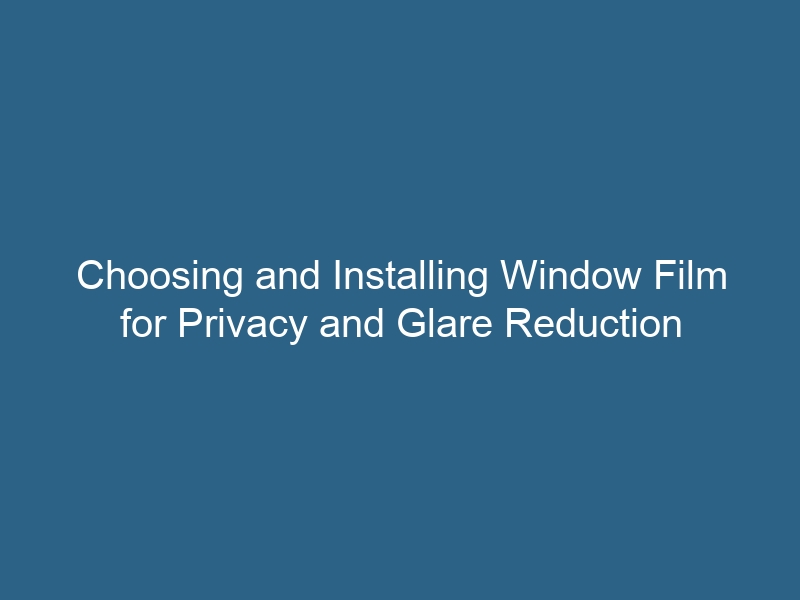Quck answer
Window films are a great solution for enhancing privacy and reducing glare in your home or office. When choosing a window film, consider the level of privacy and glare reduction you desire. Privacy films come in various opacities, from frosted to fully opaque, allowing you to choose the level of visibility from outside. For reducing glare, select a film that has a high visible light transmission (VLT) rating. Installation is a straightforward process that involves cleaning the window, measuring and cutting the film to fit, and applying it using a soapy water solution. Ensure proper adhesion and removal of any air bubbles for optimal results.
Window film provides an easy solution for reducing indoor glare and enhancing privacy, but its benefits go beyond that. Some films are made with multiple layers of polyethylene teraphthalate, a polyester material commonly used in window films. These films not only improve privacy and reduce glare, but also offer additional advantages such as protection from shattering glass, improved thermal insulation, decorative elements, and UV radiation rejection to safeguard indoor furnishings from fading.
Applying window film is a simple do-it-yourself project that can be easily done by homeowners. Most products come with installation instructions, and although it is important to read them, the process is generally similar for different types of film. However, it is worth noting that films designed to protect windows from graffiti may require additional preparation and installation from the outside.
The Importance of Window Film
When choosing window film, the type of windows you have is not the primary concern since window film adheres well to all plain window glass. The most important consideration is what you want the film to achieve, and there are various types available to meet different purposes:
Glare Control
If you are tired of direct sunlight and reflections from shiny objects causing discomfort while you work on your computer, reflective window film can help. This type of film reduces glare by reflecting the most damaging light wavelengths while allowing natural light to pass through. It provides excellent visibility without the need to squint. Dual-reflective film filters light in both directions, minimizing glare from both sides of the window. The glare reduction of this film is measured by its glare coefficient, with a higher number indicating better results.
UV Blocking
To protect valuable items such as Persian rugs and upholstery from fading, consider installing UV-blocking film. This film significantly reduces incident ultraviolet rays, which are the most harmful to materials.
Visit Page
https://go.skimresources.com

Image Credit:
Wayfair
Thermal Insulation
Window film can help reduce energy consumption by your air conditioner or keep cold air outside and lower heating costs. Thermal insulation film can be reflective or transparent, effectively reducing the thermal conductivity of your windows. Unlike other films that are applied directly to the glass, this type of film is installed over the window frame, creating a sealed air chamber on the interior side of the window.
Security
For added safety, consider using a 4-mil or thicker security film. This film acts as a safety barrier, preventing glass shards from scattering in the event of a window breakage. It also serves as a deterrent against burglars. Thicker films, ranging from 8 to 15 mil, can even provide protection against bomb blasts, although they need to be securely anchored to the window frame to be effective.
Privacy and Beautification
Window film can be used to create a one-way mirror effect, allowing you to see the outside without being seen yourself. If you want to enhance the aesthetics of your house, you can also install decorative window film with a frosty or translucent surface that offers privacy in both directions.
Items You Will Need
-
Application solution
-
Baby shampoo (if needed)
-
Paper towels
-
Tape
-
Microfiber cloth
-
Spray bottle
-
Squeegee
-
Utility knife
-
Cabinet scraper or plastic paint scraper
Installation of Window Film
Installing window film is a relatively easy DIY project for your home, but make sure to read the manufacturer’s instructions and familiarize yourself with any additional supplies that come with the film. Many products include a special application solution that needs to be applied to the film to help it adhere.
If a solution is not provided, you can make your own by adding a teaspoon of baby shampoo to a gallon of water. It is important to use soapy water and avoid using regular window cleaner, especially those containing ingredients like ammonia or vinegar, as they can degrade the film.
Step 1: Clean the Window
Using a microfiber cloth and the provided cleaning solution (or your own solution), thoroughly clean the entire glass pane, ensuring that all dirt and lint are removed and no oily residue is left behind. To expedite the process, you can put the cleaning solution in a spray bottle and spray it on the window as you wipe. Use a squeegee to remove the cleaning fluid before it dries and dry the edges of the window frame with paper towels.
Step 2: Prepare the Window Film
Unroll the window film on a flat and clean surface with the backing facing upwards. Using a utility knife, cut out a section of film that is 1 inch larger than the window pane on all sides.
Step 3: Remove the Backing
Starting from one corner, gently peel off the backing from the film using your fingers. Wetting your fingers with the cleaning solution beforehand can help avoid leaving fingerprint marks on the film. Alternatively, you can attach tape to both the film and the backing and use it to separate them.
Step 4: Place the Film on the Window
Spray the cleaning solution on the window side of the film to moisten it and improve static cling. Position the film on the window pane, ensuring that there is a 1-inch overlap on all sides and at least one side is parallel to the frame (if one side is parallel, all sides will be parallel).
Step 5: Eliminate Air Bubbles
To get rid of air bubbles, dampen the side of the film facing you with the cleaning solution. Use your palms to press the film onto the glass surface and move the air bubbles towards the edges where they can escape. Start from the center of the window and work your way to the top edge, then towards the bottom. If you have a squeegee, you can also use it to flatten the film and remove air bubbles. Some kits include a credit-card-size squeegee for this purpose.
Step 6: Secure the Edges
Press down firmly on the edges of the film against the window using the credit card squeegee provided in the kit, a plastic paint scraper, a cabinet scraper, or a real credit card (not an active one). Pay special attention to the corners to prevent the film from lifting in the future.
Step 7: Trim the Excess
Using a sharp knife, preferably a utility knife, or a razor blade safely installed in a razor blade holder, trim the excess film from around the edges. Work the blade away from each corner to avoid leaving a piece of film hanging from the corner and lifting the rest of the film off the window.
Step 8: Remove Excess Moisture
Cover the tool you used to secure the edges with a piece of low-lint microfiber cloth. Spray cleaning solution on the film, then run one edge of the scraper sideways along the film to push excess moisture underneath it towards the edge of the pane.
Step 9: Wipe the Window Clean
Give the window a final spray with the cleaning solution and wipe it down with a microfiber cloth. The film will permanently adhere to the glass, but if you used adhesive, it will take some time to harden. The bond should be mostly permanent about 30 minutes after installing the window film, but it may take four to eight days for it to fully cure.


